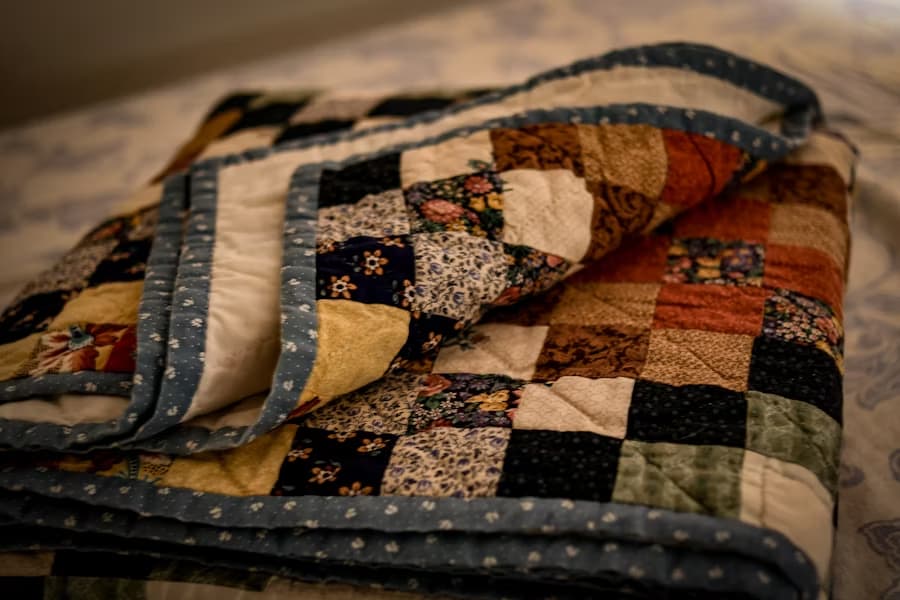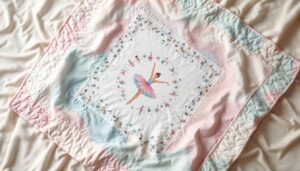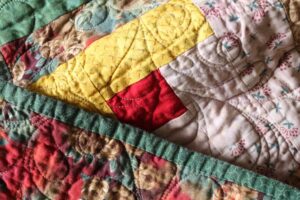Patchwork is an amazing art of creating textile paintings, quilts and accessories using pieces of fabric. In order to make the first steps in this fascinating business, it is important not only a creative idea, but also a set of the right tools. In this article we will tell you about ten indispensable tools for beginner quilters, which will help you to create beautiful and neat products.
1. Rotary Cutter
When you start working with patchwork, precision and accuracy are key. A paring knife is one of the most important tools to help you cut fabric with minimal effort. Unlike regular scissors, a paring knife allows you to cut multiple layers of fabric at once. It is ideal for working on large projects, such as quilts or bedspreads, where you need to cut many identical pieces of fabric.
The cutting knife works on the principle of a circular blade, which can be easily replaced. For beginners, it is recommended to choose a knife with a blade diameter of 45 mm, as this is a universal size for most tasks. For safety, it is better to use the knife complete with a self-healing cutting mat, which will provide you with a flat surface and protect the table from damage.
2. A self-healing cutting mat
Every quilter knows that cutting fabric without a cutting mat is not a good choice. A cutting mat is a special protective material that helps you cut fabric carefully without damaging your work surface. A self-healing mat is particularly useful as it does not leave deep marks on the fabric after cutting it and it returns to its original state.
Mats come in a variety of sizes, but an 18×24 inch (45×60 cm) mat is ideal for beginners. This size is comfortable for working with most types of fabric and doesn’t take up too much space on your work table. Pads often have a grid with rulers to help you accurately measure and cut your fabric to the right size.
3. Patchwork ruler
A ruler is an important tool for cutting fabric accurately and helps minimize errors. Here are a few key aspects to consider when choosing a ruler:
- Material: Patchwork rulers are usually made of clear acrylic, which allows you to see the fabric and work with maximum precision.
- Measuring Lines: Many rulers have extra angles and markings to help you cut your fabric at the right angles.
- Size: For beginners, a 6×24 inch (15×60 cm) ruler is ideal, as it is versatile and fits most blocks.
- Non-slip surface: It is important to choose a ruler with a non-slip surface so that it does not move while you are working, ensuring accuracy and safety.
4. A sewing machine with a 1/4 inch presser foot
Although you can also use hand sewing for patchwork, a sewing machine speeds up the process considerably. It is very important that your machine be equipped with a special sewing foot with a 1/4-inch seam allowance. This is the standard allowance for most quilts, and it helps you accurately assemble blocks without distorting their shape.
If your sewing machine doesn’t have this foot, don’t worry – many machines allow you to buy additional feet that you can install. This will help you achieve perfect seams and get even, neat stitches.
5. Iron and ironing board
Ironing is an important process in patchwork that helps you achieve neat and even seams. Regular ironing of the fabric before and after sewing helps to get rid of creases and promotes proper assembly of the blocks. It is best to use an iron with a steam function as it helps to smooth fabrics faster and more efficiently.
An ironing board is also important so that the iron does not leave marks on the surface of the table. If you do not have a standard ironing board, you can use any convenient analog with a good surface. However, having a quality board will allow you to work more comfortably and safely.

6. Fabric and thread scissors
To work with patchwork, you will need two types of scissors: fabric scissors and thread scissors. Fabric scissors should be sharp and comfortable for cutting even the thinnest fabrics. It is important to choose scissors with good blades that will cut the fabric effortlessly and with maximum precision.
Thread scissors are small scissors that are essential for neatly trimming excess threads after sewing. They will help you get rid of excess thread ends without damaging the fabric or leaving marks.
7. Flat head pins
Pins are an indispensable tool for securing layers of fabric before sewing. For patchwork, flat-headed pins are particularly important and have several advantages:
- Easy sewing: Flat-head pins make it easy to pierce several layers of fabric and sew over them without catching or damaging the material.
- Use with a sewing machine: Flat head pins do not interfere with the sewing machine foot, allowing the machine to move freely and without jamming.
- Plastic heads: Flat heads are often plastic, which prevents overheating and fabric damage, ensuring safe and comfortable use.
These pins will help you pin your fabrics with the utmost precision and avoid sewing problems.
8. Fabric markers
Fabric markers are an important tool for marking on the material. They are essential for precise alignment, creating seam lines or block marks. Here are the main types of markers:
- Markers with disappearing ink: These markers disappear after a few hours or after washing, making them ideal for temporary markings.
- Chalk markers: These leave clear lines that can be easily erased with a damp cloth or special brush.
- Water-soluble pens: These markers erase on contact with water, making it easy to remove the markings without damaging the fabric.
When choosing a marker, it is important to consider that it will easily disappear from the fabric without leaving a residue. Always test the marker on a small piece of material before use to make sure it is reliable.
9. Needles and threads for quilting
The right needles and threads are important components of quality sewing. For patchwork, it is best to use a medium thickness needle with a universal eye. Threads should be strong and appropriate for the type of fabric you are working with. Polyester or cotton threads are suitable for most quilts.
If you are working with thicker fabrics or multiple layers, choose needles with a sturdier, sharper tip to avoid getting stuck and damaging the fabric.
10. Stitch puller
Mistakes are an essential part of learning, and a seam puller can help you easily and neatly undo seams without damaging the fabric. A seam puller is a small tool with a hook that helps you carefully cut threads when something has gone wrong. This is especially important for complex projects when you need to correct small inaccuracies.
Don’t be afraid to undo seams. Learn to use a suture puller and your experience will get better every time.


